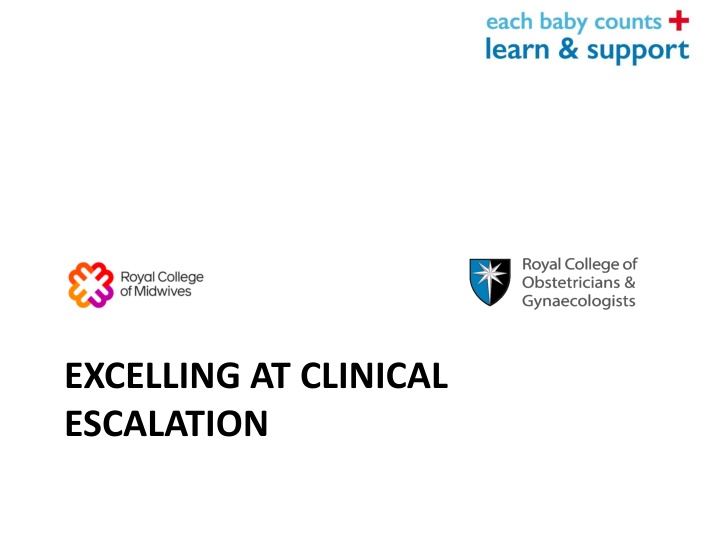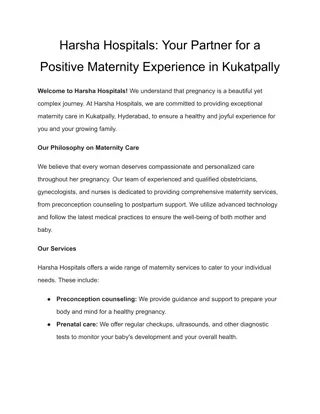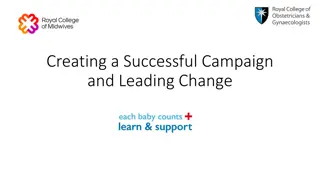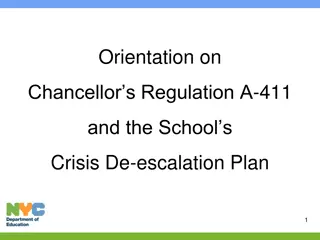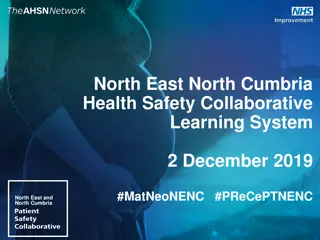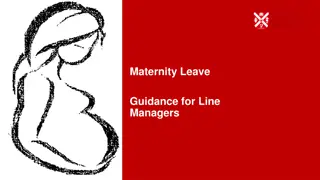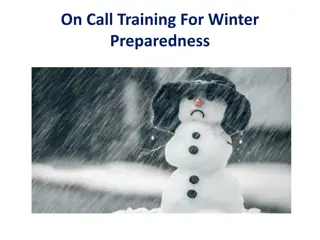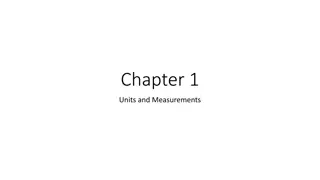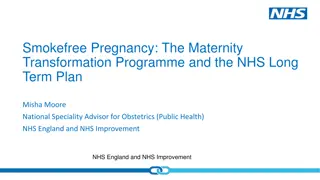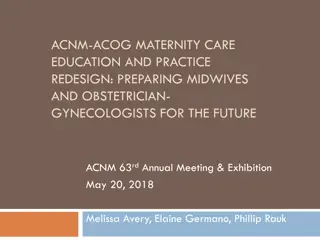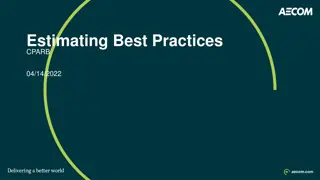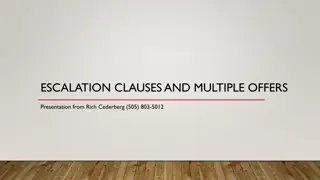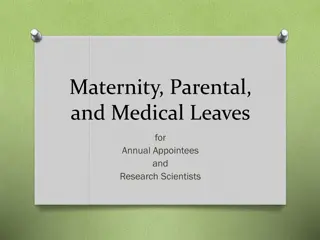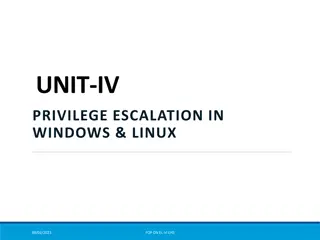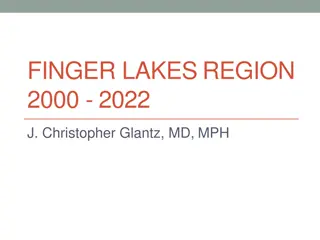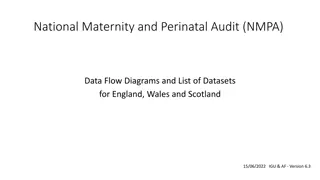Clinical Escalation: Building Effective Communication in Maternity Units
Exploring the importance of clinical escalation in maternity units, this session outlines the components and practices involved in identifying, communicating, and acting upon clinical concerns. It emphasizes recognizing deviation from normality, effective communication, and taking appropriate actions to ensure patient safety and positive outcomes. Challenges and opportunities for improvement are discussed, highlighting the need for consistent approaches to support education, facilitate conversations, and excel in clinical escalation.
Download Presentation

Please find below an Image/Link to download the presentation.
The content on the website is provided AS IS for your information and personal use only. It may not be sold, licensed, or shared on other websites without obtaining consent from the author.If you encounter any issues during the download, it is possible that the publisher has removed the file from their server.
You are allowed to download the files provided on this website for personal or commercial use, subject to the condition that they are used lawfully. All files are the property of their respective owners.
The content on the website is provided AS IS for your information and personal use only. It may not be sold, licensed, or shared on other websites without obtaining consent from the author.
E N D
Presentation Transcript
EXCELLING AT CLINICAL ESCALATION
ESCALATION Excelling at Conversations and Escalations Helping maternity units to build the right culture and conditions to enable effective clinical escalation and communication
Session Outline Defining Clinical Escalation Where are we now? How might we continue to improve Understand how we all do fresh eyes case exercise Think about taking the same approach with our conversations? . Introduce Teach or Treat approach Reflect on escalation language and documentation What now what have you learnt and what will you do now?
Components of Clinical Escalation Identify Communicate Act
What is escalation? Correctly recognise deviation from normality Appreciation of risk factors Be aware of when you are escalating Communicate Appropriate response and speed Infrastructure staff / theatres available Closed loop structured communication Flattened MDT hierarchy Assertive escalation / receptive action Identify Act
Where are we now? How can we continue to improve? Where are we now? National learning Each Baby Counts 2019 identified the following: 59% of cases - CTG and FBS contributed to poor outcomes 13% - equipment problems identified 33% - interpretation errors 44% - failure to act on suspicious or pathological CTG 3% - FBS errors Local learning HSIB reviews How can we continue to improve? the million $ question! Conversations - Adopting a consistent approach that supports education, sharing learning and enables difficult and challenging conversations to happen? Excelling at escalation Identify, Communicate, Act!
CTG categorised as abnormal during IOL process escalated to shift leader advice given to change position and ensure drinking Abnormal CTG was not escalated to the obstetric team Throughout the labour there was evidence of good practice where the CTG trace . Was escalated by the midwifery team to the obstetric team for review when the CTG became difficult to categorise or interpret Developing risk factors clinical findings of the review should have been escalated and discussed with a senior member of the obstetric team Staff raised concerns and escalated for an obstetric review. The full obstetric team were unavailable to attend as they were in the operating theatre. Three further escalations were made in relation to the Mother s rising MEOWS. No bedside review; evidence of verbal discussion and instructions
CTG was not recognised to be abnormal. The features of the CTG were attributed to LOC and this became the focus, without consideration of the whole clinical picture. Reviewed the CTG after 30 minutes of conservative measures as planned however did not then escalate the review Shift leader did not escalate concerns regarding the deterioration of the CTG to the consultant on call until 22:59 hours despite arranging for a second theatre
Communication Identify Act
Importance of speaking up for safety Psychological safety- we should all feel safe/ able to speak our concerns however small What are the enablers & barriers? When a concern is raised to you how do you respond? How can we be supported to speak up in this unit? Who can you speak up to if do not feel heard? Does the SBAR handover tool help us? Is there another tool we can use?
The importance of behaviour The big challenge facing healthcare and escalation is about how we behave towards one another. Psychological safety is key to feeling safe and being able to raise concerns Rudeness and incivility affects us and onlookers. It results in reduced performance, quality of work and cognitive capacity - feeling distracted, reducing commitment and with holding effort
CTG example Case background: Age 30, post dates IOL at T+12. BMI 33. x1 episode of reduced FM s @ 39+3. ARM with thin stale meconium, now on oxytocin and epidural. Labour progressing normally. Normal CTG at last fresh eyes 10.00 and 9cm on VE, 10.35, feeling urge to push In pairs, please fresh eyes and classify the following CTG
Reflection: fresh eyes conversation What is your reflection on the process and conversation you have just had? Did you classify using terminology? Did you both agree on the classification? How did you reach agreement? What did you both say? What would you have done if you did not agree? Would that conversation look any different if factors such as distractions, stress (you or others) , if its busy, if you ve not had a break and are hangry ! If you don t feel psychologically safe? How might that conversation look escalating and challenging your colleague?
What are the implications on safety? We know this area of care is challenging and its not surprising that we do not always agree it doesn t just happen with fetal monitoring! National and local learning have identified themes and areas for us to focus our energy This is about the art of conversation and an environment of psychological safety Maintaining an environment of Constructive friction Having a difference of opinion is ok . We disagree and challenge in a respectful way. This is essential for learning and growth, for safety This is inherently linked to the 3 step Identify, Communicate, Act escalation process for improving safety How can we do this?
All taking the same approach? Teach or Treat is a simple practical approach that can be used during escalation conversations TEACH This is what I think because . and What do you think and why ? It feels a safe way to open up conversations, exposes different perceptions and allows education , shared learning and for development of shared mental models. TREAT lets treat by doing x If you do not agree escalate .. seek a 3rd opinion!
How does this translate into reality? 1. Review the full clinical picture and any risk factors - using knowledge and tools (CTG, MEOWs, NEWTS) We can ask the question How are mum and baby(s)? 2. Do fresh eyes/ears independently, compare and discuss together This is what I think because . Tell me what you think and why . This is the basis of a Teach or Treat approach
Reflections Escalation language and documentation Escalation language? Do you feel confident to escalate? Do you consistently use agreed terminology and tools to communicate in escalation situations? I am concerned. I have classified the CTG as .. Could you please review .. in X time frame. The SBAR is Documentation of escalations? How do you document escalations? X asked to review/review CTG vs Escalated to . re concern .. Requested review in X time frame Response was ..
Framing Escalation Do you always know when you re escalating? Do you know what response you need? Do you know when you re being escalated to? Do you always know what response is needed?
Improving Escalation We can improve clinical escalation using safety critical language: Escalating a clinical situation? Frame what you need to say with safety critical language. Here are some examples of how you might usually communicate, then how you can use AID: A DVICE 'Nadia in room 7 is fully dilated and wants to use the pool?' 'I am asking for your ADVICE, around using the birth pool for Nadia in room 7 as she has a borderline BP' I NFORM 'Just to let you know Aaliya in room 4 is fine now.' 'I am INFORMING you - that Aaliya in room 4 had a kiwi at 05:30 and a PPH of 1000mls but is stable now' D O 'Maggie is fully and pushing with a dodgy CTG' 'I need you to (DO) come straightaway to review the CTG in room 2 which is deteriorating' IDENTIFY COMMUNICATE ACT We would like to introduce 'AID' throughout the department. If you have a clinical concern to escalate please frame your communication: STILL CONCERNED - ESCALATE FURTHER I am asking for ADVICE... I am INFORMING you... I need you to (DO)...
Using AID AID is as a clear and simple communication tool which initiates escalation conversations using 3 simple phrases: I am asking you for Advice , I am Informing you and I need you to Do It is designed to precede SBAR (situation, background, assessment, recommendation)
Using AID (2) It can also be used in reverse ie if it is unclear what response the person escalating is looking for, the clinician being escalated to can ask the following: Are you asking me for Advice , Are you Informing me , Do you need me to DO something / what would you like me to DO ? It is not expected that you force these exact phrases into conversations, but that the principles of ADVICE, INFORM, DO are used as a framework when escalating.
Why, When? Clearly identify when escalation is taking place Elicit a time critical response, reducing delays Help prioritisation for clinicians who may receive multiple escalations within any given shift (band 7 midwifery co- ordinators, consultants) Empower junior staff Used .. At the outset of all escalation conversations between ALL members of the MDT Particularly helpful when escalating to non resident clinicians (usually consultants) and during periods of high activity
Session recap, What now? What have you learnt? You know where we are we now and have started to think about how can continue to improve Fresh eyes process reflecting on this and how you do things (case exercise) Introduced Teach or Treat approach for consistency and to educate for shared learning Introduced AID framing escalation conversations with safety critical language What will you take away from this session? What will you do now to make change happen?........
